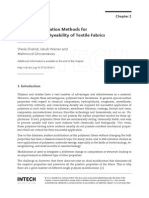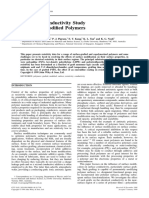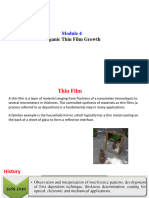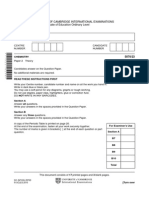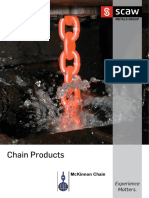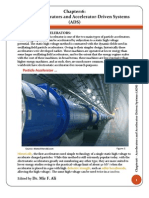0 ratings0% found this document useful (0 votes)
65 viewsSurface Coating: Toxicology Considerations in Nanomedicine
Surface Coating: Toxicology Considerations in Nanomedicine
Uploaded by
Muhammad farhanSurface coatings are used to modify the properties of materials like magnesium alloys, nanomaterials, and electrodes. Coatings can protect surfaces, diminish toxicity, stabilize particles, and control properties. Coatings are applied through various methods like dip coating, spray coating, and self-assembly of nanoparticles. Coatings can offer benefits like enhanced performance, wear resistance, and barrier characteristics when incorporated into composites and membranes.
Copyright:
© All Rights Reserved
Available Formats
Download as DOCX, PDF, TXT or read online from Scribd
Surface Coating: Toxicology Considerations in Nanomedicine
Surface Coating: Toxicology Considerations in Nanomedicine
Uploaded by
Muhammad farhan0 ratings0% found this document useful (0 votes)
65 views3 pagesSurface coatings are used to modify the properties of materials like magnesium alloys, nanomaterials, and electrodes. Coatings can protect surfaces, diminish toxicity, stabilize particles, and control properties. Coatings are applied through various methods like dip coating, spray coating, and self-assembly of nanoparticles. Coatings can offer benefits like enhanced performance, wear resistance, and barrier characteristics when incorporated into composites and membranes.
Original Title
Surface Coating
Copyright
© © All Rights Reserved
Available Formats
DOCX, PDF, TXT or read online from Scribd
Share this document
Did you find this document useful?
Is this content inappropriate?
Surface coatings are used to modify the properties of materials like magnesium alloys, nanomaterials, and electrodes. Coatings can protect surfaces, diminish toxicity, stabilize particles, and control properties. Coatings are applied through various methods like dip coating, spray coating, and self-assembly of nanoparticles. Coatings can offer benefits like enhanced performance, wear resistance, and barrier characteristics when incorporated into composites and membranes.
Copyright:
© All Rights Reserved
Available Formats
Download as DOCX, PDF, TXT or read online from Scribd
Download as docx, pdf, or txt
0 ratings0% found this document useful (0 votes)
65 views3 pagesSurface Coating: Toxicology Considerations in Nanomedicine
Surface Coating: Toxicology Considerations in Nanomedicine
Uploaded by
Muhammad farhanSurface coatings are used to modify the properties of materials like magnesium alloys, nanomaterials, and electrodes. Coatings can protect surfaces, diminish toxicity, stabilize particles, and control properties. Coatings are applied through various methods like dip coating, spray coating, and self-assembly of nanoparticles. Coatings can offer benefits like enhanced performance, wear resistance, and barrier characteristics when incorporated into composites and membranes.
Copyright:
© All Rights Reserved
Available Formats
Download as DOCX, PDF, TXT or read online from Scribd
Download as docx, pdf, or txt
You are on page 1of 3
Surface Coating
Surface coatings are used to protect the surface of magnesium and
its alloys to prevent their direct contact with air and moisture so that
the electrochemical corrosion reactions described above will not
occur or occur at a very low rate Surface coatings are frequently
applied in one or more layers to customize QD for specific
applications, such as the use of hydrophilic coatings to increase
solubility in biologically compatible medium, coatings (or ‘shells’)
that reduce leaching of metals from the core and reactive surface
groups that facilitate conjugation to therapeutic and diagnostic
macromolecules, receptor ligands, or antibodies.
Toxicology Considerations in Nanomedicine
Surface coating can be utilized on nanomaterial for modifying or
diminishing the adverse effects associated with them. Surface
coatings can also be used to modify properties like stabilization
of particles and arrest dissolution and discharge of noxious ions .
Coating on the surface of nanomaterials was used to conceal
surface charge and surface composition. Sometimes coatings on
nanomaterials are degradable and liable in the biological medium
that leave the toxic material in its initial arena. Several reports
suggested that severe inflammatory and immunological responses
can occur due to substances used in surface coating of
nanomaterials. Further in some nanomedicines such as QDs,
coating is necessary in order to limit the adverse affect of core
material (cadmium). Moreover, a coating can increase core’s
robustness, limits ion leaching, and enhances water dispersibility
Self-assembled, nanophase particle coating
Surface coating that enables strong covalent bonding at the substrate–
coating interface can offer an enhanced performance and long-term
stability to a substrate. Nanoparticles and nonstructured, recently, have
gained increasing interest for industrial application such as wear
and abrasion resistance. This novel approach to robust interface
bonding is based on a preformed, self-assembled, nanophase particle
sol–gel system that has the potential to produce a fully dense protective
surface coating. The fundamental principle is to generate
nanoscale particles from an aqueous solution with an inorganic core by
arresting the particle growth using a surfactant and a subsequent
creation of polymerizable or reactive organic exterior with an inorganic
core. This is further crosslinked with an organic crosslinking agent to
crosslink the nanoparticles to form a dense, protective film on the
substrate Nanostructured surface coating based on SNAPs in a
polymeric matrix can be a potential candidate for wear-resistant,
lubricating coating. Significant property enhancements have been
reported for such hybrid systems including increased toughness, wear
resistance, barrier characteristics, and increased oxidation Therefore, a
polymeric coatingincorporating such a multifunctional nanostructured
component is able to offer many demanding properties of a self-
lubricating surface.
Membrane properties in membrane distillation
Surface coating is a simple and inexpensive method for surface
modification of the membrane and it can be done easily in industrial
operations and also on a large scale. In this way, the membrane structure is
covered by a coated layer. There is a possibility of penetration of the
coated layer into the pores of the membrane, so it should be used in very
high molecular weight polymerfor the coated layer. The coated layer can
be controlled by adjusting the operating parameters. Membranes with a
coated layer have a good stability in the long term without being wet. The
use of these membranes reduces cost and consumption because there is
less heat loss surface between them. coated layer on the membrane surface
is unstable, so it is the major problem in the surface coating method. This
is because there is a relatively weak interaction between the membrane
surface and the coated layer and the coated layer is separated from the
membrane surface during the process or during washing operations. In
order to anchor the coated layer, chemical treatments such
as sulfonation or crosslinking on the membrane surface can be used in
some cases. The surface coating is applied for the surface modification of
both hydrophyllic and hydrophobic surfaces.
Electrochemical and Chemical Modifications of Electrode
Surfaces and Interphases for Li–Ion Batteries
Surface coatings on the composite electrode can be prepared by simple
processes like dip coating and spray pyrolysis.article a dip coating procedure
with a precursor of acrylic monomerand a UV-active initiator which could
be conveniently applied to fabricate thin polymer layers onto
LiCoO2 composite electrodethrough free-radical polymerization.79 More
refined deposition methods (e.g., CVD and ALD), as previously described,
can also be applied at the composite level. A comparative study of
applying a nanoscale Al2O3 coating on both the active material of natural
graphite and its composite electrode by ALD technique was presented.100 It
showed a drastic fading of cycling performance of ALD-treated active
material powders, but superior cell behaviour in the ALD-treated
composite electrode. This indicates that applying coating on the composite
electrode may be favourable to maintain the overall
electric conductivity within the composite.
ENERGY-EFFICIENT WINDOWS: PRESENT AND
FORTHCOMING TECHNOLOGY
Surface coatings with thicknesses in the range 0.01 to 1 μm can modify
the radiative surface properties of glass and thereby
produce end efficiency. Two techniques are in widespread use for
preparing such coatings on the scale of square metres, viz. Sputter
deposition and spray proylysis. A detailed description of the
technologies is not attempted here, but their operating principles and
pros and cons will be outlined.
Surface coated fabrics
Surface coatings applied to filter fabrics can enhance one or more
of the filtration properties of the fabric. The coating may be sprayed
on as a liquid or laid down as a sheet which is then bonded to the
fabric. Microporous polymer coatings may be used to provide a
smoother and fine aperture size to the fabric surface, which may
enable easier detachment of the cake and prolong the lifetime of
the medium.
You might also like
- Lab Report 5 CHM138Document7 pagesLab Report 5 CHM138Muhd Mirza Hizami50% (2)
- Floating Leaf Disk Assay For Year 11Document3 pagesFloating Leaf Disk Assay For Year 11John OsborneNo ratings yet
- 20 Surface Modification of Plastics: Kenth S. JohanssonDocument45 pages20 Surface Modification of Plastics: Kenth S. JohanssonLuis Alberto Escalante PradoNo ratings yet
- 1 s2.0 S1385894718318527 MainDocument15 pages1 s2.0 S1385894718318527 MainKArenNo ratings yet
- Field Test of A Self Sintering Anti Soiling Thin Film Coating For Solar PVDocument8 pagesField Test of A Self Sintering Anti Soiling Thin Film Coating For Solar PVEbenezer ButarbutarNo ratings yet
- 1 s2.0 S0257897222000330 MainDocument14 pages1 s2.0 S0257897222000330 MainLiviu BadeaNo ratings yet
- Nanocoating PresentationDocument52 pagesNanocoating Presentationstanlyd15No ratings yet
- Texture Analysis of Hydrophobic Polycarbonate and Polydimethylsiloxane Surfaces Via Persistent HomologyDocument15 pagesTexture Analysis of Hydrophobic Polycarbonate and Polydimethylsiloxane Surfaces Via Persistent HomologyJoeNo ratings yet
- International Journal of Chemtech Research: Neetu SinghDocument5 pagesInternational Journal of Chemtech Research: Neetu Singhthai avvai100% (1)
- Supertough Wear-Resistant CoatingsDocument9 pagesSupertough Wear-Resistant CoatingssaatehNo ratings yet
- Materials Today: Proceedings: Deepanjana Adak, Raghunath Bhattacharyya, Hiranmay Saha, Pradipta Sankar MaitiDocument5 pagesMaterials Today: Proceedings: Deepanjana Adak, Raghunath Bhattacharyya, Hiranmay Saha, Pradipta Sankar MaitiAAKIB QURESHINo ratings yet
- Surface Modification of Ion Exchange Membranes Methods Characteristics and PerformanceDocument13 pagesSurface Modification of Ion Exchange Membranes Methods Characteristics and PerformanceLuis AlvarezNo ratings yet
- Surface & Coatings Technology: Young-Yeon Ji, Yong-Cheol Hong, Suck-Hyun Lee, Sung-Dae Kim, Sang-Sik KimDocument5 pagesSurface & Coatings Technology: Young-Yeon Ji, Yong-Cheol Hong, Suck-Hyun Lee, Sung-Dae Kim, Sang-Sik KimDjo BrainNo ratings yet
- Preparation of Super Hydrophobic Coating For Insulator Against Icing FlashoverDocument7 pagesPreparation of Super Hydrophobic Coating For Insulator Against Icing Flashoverاحمد عدنانNo ratings yet
- Flyer Plasmatechnology ApplicationsDocument2 pagesFlyer Plasmatechnology ApplicationsJoe RanteNo ratings yet
- Surface Modification Methods For Improving The Dyeability of Textile FabricsDocument20 pagesSurface Modification Methods For Improving The Dyeability of Textile Fabricshamidrahmany3657No ratings yet
- TFC Polyamide Membranes Modified by Grafting of Hydrophilic Polymers - An FT-IR AFM TEM StudyDocument10 pagesTFC Polyamide Membranes Modified by Grafting of Hydrophilic Polymers - An FT-IR AFM TEM StudyAlisya AlyaNo ratings yet
- Nghiên cứu khoa họcDocument9 pagesNghiên cứu khoa họcThư HuỳnhNo ratings yet
- Characterization of Metallized Biaxially Oriented Polypropylene FilmDocument10 pagesCharacterization of Metallized Biaxially Oriented Polypropylene FilmLaboratory Plant 7No ratings yet
- Electrical Conductivity StudyDocument8 pagesElectrical Conductivity Studynadir adelNo ratings yet
- 1 s2.0 S1369800119308364 MainDocument7 pages1 s2.0 S1369800119308364 MainRAJESH KRISHNANo ratings yet
- Journal Pre-ProofsDocument38 pagesJournal Pre-ProofslapakkawNo ratings yet
- The Complexities of HighDocument9 pagesThe Complexities of HighLam Ah KaoNo ratings yet
- Nano 2021-22 End SemDocument9 pagesNano 2021-22 End SemSatyabrata PandaNo ratings yet
- Biopolymers Nanocomposite For Material Protection Enhancem 2016 Progress inDocument12 pagesBiopolymers Nanocomposite For Material Protection Enhancem 2016 Progress inNurhanifa AidyNo ratings yet
- Surface EngineeringDocument8 pagesSurface Engineeringبلسم محمود شاكرNo ratings yet
- Paper On SoilingDocument7 pagesPaper On SoilingSuchanond KaewjindaNo ratings yet
- Chemical EngineeringDocument4 pagesChemical EngineeringrayhanshaidiNo ratings yet
- Tiraferri A Et Al DX - Doi.org:10.1021:am200536p - ACS Appl. Mater. Interfaces 2011, 3, 2869-2877Document9 pagesTiraferri A Et Al DX - Doi.org:10.1021:am200536p - ACS Appl. Mater. Interfaces 2011, 3, 2869-2877parnaz88No ratings yet
- Module 4 Thin Films ModifiedDocument97 pagesModule 4 Thin Films Modifiedhemanth.vishnu2002No ratings yet
- Nanocomposites Properties and ApplicationsDocument6 pagesNanocomposites Properties and Applicationsfafy mohammedNo ratings yet
- Leading in Sustainability & Productivity Improvements in CanmakingDocument4 pagesLeading in Sustainability & Productivity Improvements in CanmakingJeanNo ratings yet
- Small - 2023 - RatwaniDocument13 pagesSmall - 2023 - Ratwanichirag ratwaniNo ratings yet
- Evaluation of Self-Healing Properties of Inhibitor Loaded Nanoclay-Based Anticorrosive Coatings On Magnesium Alloy AZ91DDocument12 pagesEvaluation of Self-Healing Properties of Inhibitor Loaded Nanoclay-Based Anticorrosive Coatings On Magnesium Alloy AZ91DDiana SantosNo ratings yet
- Emulsion Separation and Fouling of Electrospun Polyacrylonitrile Membranes For Produced Water Applications - ScienceDirectDocument52 pagesEmulsion Separation and Fouling of Electrospun Polyacrylonitrile Membranes For Produced Water Applications - ScienceDirectMOH AMANNo ratings yet
- Nanocoatings: Randa Abdel-KarimDocument37 pagesNanocoatings: Randa Abdel-KarimEnrique FrancoNo ratings yet
- Guo 2021Document11 pagesGuo 2021Muhammadzafar ullahNo ratings yet
- Effect of Nano-SiO2 Modification On Mechanical andDocument18 pagesEffect of Nano-SiO2 Modification On Mechanical anditsmetheboy267No ratings yet
- Enhanced Tribological Properties of Wind Turbine Engine Oil Formulated With Flower-Shaped MoS2 Nano-AdditivesDocument10 pagesEnhanced Tribological Properties of Wind Turbine Engine Oil Formulated With Flower-Shaped MoS2 Nano-AdditivesZoubir SaidiNo ratings yet
- Laser Assisted Processing of Aluminum Alloy For The Fabri - 2020 - Surface and CDocument10 pagesLaser Assisted Processing of Aluminum Alloy For The Fabri - 2020 - Surface and CFerry SetiawanNo ratings yet
- 1 s2.0 S0011916421005075 MainDocument11 pages1 s2.0 S0011916421005075 MainNghiep PhamNo ratings yet
- Thiol-Ene NanokompozitaiDocument12 pagesThiol-Ene NanokompozitaiAlgirdas LazauskasNo ratings yet
- Sol-Gel Solar CellDocument5 pagesSol-Gel Solar CellJosé Carlos GBNo ratings yet
- 2020 Modification of PolymersDocument10 pages2020 Modification of PolymersgolokchandmandalNo ratings yet
- 1 s2.0 S0257897220313438 MainDocument11 pages1 s2.0 S0257897220313438 MainBANNOUR OthmaneNo ratings yet
- Mahtabani 2019Document5 pagesMahtabani 2019daaanuNo ratings yet
- thin-filmDocument15 pagesthin-filmsahasNo ratings yet
- Functionalized Graphene Oxide Epoxy Phenolic Novolac Nanocomposite An Efficient Anticorrosion Coating On Mild Steel in Saline MediumDocument17 pagesFunctionalized Graphene Oxide Epoxy Phenolic Novolac Nanocomposite An Efficient Anticorrosion Coating On Mild Steel in Saline Medium63110064No ratings yet
- Introduction J Gaps J ObjectivesDocument4 pagesIntroduction J Gaps J ObjectivesAbhishek PareekNo ratings yet
- Corona PretreatmentDocument8 pagesCorona PretreatmentcehigueraNo ratings yet
- 1 s2.0 S0300944020300771 MainDocument20 pages1 s2.0 S0300944020300771 Maindanish.hakeem251No ratings yet
- 1 s2.0 S0169433208003103 MainDocument5 pages1 s2.0 S0169433208003103 MainFranz LisztNo ratings yet
- Sun 2020Document11 pagesSun 2020mepcNo ratings yet
- 1-s2.0-S277282342400006X-mainDocument10 pages1-s2.0-S277282342400006X-mainUsman AliNo ratings yet
- Lamination Vs CoatingDocument7 pagesLamination Vs CoatingJscribd100% (1)
- Chapter 05Document8 pagesChapter 05vishal teraiyaNo ratings yet
- Constantin R31Document5 pagesConstantin R31Tuấn Anh Phạm HoàngNo ratings yet
- Khan2019 Article SynthesisAndPropertiesOfPolyelDocument16 pagesKhan2019 Article SynthesisAndPropertiesOfPolyelpalpandi.mNo ratings yet
- Graphene-Based Polymer Coatings For Preventing Marine Corrosion: A ReviewDocument20 pagesGraphene-Based Polymer Coatings For Preventing Marine Corrosion: A Reviewvedered136No ratings yet
- Nanosphere LithographyDocument9 pagesNanosphere LithographyapjcraNo ratings yet
- Intelligent Self-Healing Corrosion Resistant Vanadia Coating For AA2024Document11 pagesIntelligent Self-Healing Corrosion Resistant Vanadia Coating For AA2024saleh90No ratings yet
- The Enablers: Our Continuous Carbon Fiber TowsDocument16 pagesThe Enablers: Our Continuous Carbon Fiber TowsOnder TemelNo ratings yet
- Structural Steel DesignDocument108 pagesStructural Steel DesignMilomir Gavrilovic77% (13)
- Aits 2324 Ot I Jeea TD Paper 2 OfflineDocument14 pagesAits 2324 Ot I Jeea TD Paper 2 OfflineAshish SharmaNo ratings yet
- University of Cambridge International Examinations General Certificate of Education Ordinary LevelDocument20 pagesUniversity of Cambridge International Examinations General Certificate of Education Ordinary Levelmstudy123456No ratings yet
- Astm D 2471 PDFDocument3 pagesAstm D 2471 PDFStephen JohnNo ratings yet
- TYPE 1648/2648/3648: API 682 Category II and III Type A Pusher SealsDocument6 pagesTYPE 1648/2648/3648: API 682 Category II and III Type A Pusher Sealsmohamed musaNo ratings yet
- Mode of Action Chemical Family Active Ingredient Hrac & Wssa Code Retired Hrac CodeDocument9 pagesMode of Action Chemical Family Active Ingredient Hrac & Wssa Code Retired Hrac CodeArysta Miguel Enrique Alvarez VargasNo ratings yet
- Assignment 1Document12 pagesAssignment 1Tshiamo MotaungNo ratings yet
- Dna and Protein Synthesis CrosswordDocument1 pageDna and Protein Synthesis CrosswordAnthony MoloneyNo ratings yet
- Name: Sajeel Khan Roll#:M.phil-SSP-03-F19 Class: M.phil SSP (Morning) Subject: Optical Properties of Solid Submitted TODocument8 pagesName: Sajeel Khan Roll#:M.phil-SSP-03-F19 Class: M.phil SSP (Morning) Subject: Optical Properties of Solid Submitted TOAnonymous f7wV1lQKRNo ratings yet
- Scaw Chain Products BrochureDocument7 pagesScaw Chain Products Brochurescm996No ratings yet
- Protection of Oil Storage Tanks Against Direct Lightning Strikes: Self Protection Scheme or Standalone LPS?Document6 pagesProtection of Oil Storage Tanks Against Direct Lightning Strikes: Self Protection Scheme or Standalone LPS?YERRAGUNTA NAVEEN KUMARNo ratings yet
- Experiment 3 - Determination of Keq - DC - RevDocument4 pagesExperiment 3 - Determination of Keq - DC - RevPatrickNo ratings yet
- MSDS - Chá de Bugre Extrato Seco (2-2)Document6 pagesMSDS - Chá de Bugre Extrato Seco (2-2)Ariana GonzalezNo ratings yet
- المعادنDocument9 pagesالمعادنOsama TahanNo ratings yet
- Chapter 16 - Nuclear Accelerators and Accelerator-Driven SystemsDocument9 pagesChapter 16 - Nuclear Accelerators and Accelerator-Driven SystemsDr. Mir F. AliNo ratings yet
- ColaWet A-100Document3 pagesColaWet A-100mndmattNo ratings yet
- Laser Removal of TiN Coatings From WC Micro-Tools and In-Process MonitoringDocument7 pagesLaser Removal of TiN Coatings From WC Micro-Tools and In-Process MonitoringmarimuthusundarNo ratings yet
- Ladle Flow Control Refractories and EquipmentDocument8 pagesLadle Flow Control Refractories and EquipmentÍcaro GavaNo ratings yet
- Solution To Mid Term ExamDocument9 pagesSolution To Mid Term ExamMariel Miraflores100% (1)
- RCR Efficiency CalculationDocument6 pagesRCR Efficiency CalculationPublic DemandNo ratings yet
- Microsoft PowerPoint - Ester Cured Sodium SilicateDocument29 pagesMicrosoft PowerPoint - Ester Cured Sodium SilicateYtyus BlackNo ratings yet
- Ion ExchangerDocument13 pagesIon ExchangerMark Jed Dela CruzNo ratings yet
- Types and Properties of LubricantsDocument2 pagesTypes and Properties of Lubricantsaeronautical rajasNo ratings yet
- Effect of PH' in The Enzyme Activity (Guide Question)Document2 pagesEffect of PH' in The Enzyme Activity (Guide Question)rhenzyl ganoNo ratings yet
- Role of Free Radicals in Health and DiseaseDocument49 pagesRole of Free Radicals in Health and DiseaseKuzhandai VeluNo ratings yet
- Kemet Flat Lapping and Polishing CatalogueDocument6 pagesKemet Flat Lapping and Polishing Cataloguevantuan17792No ratings yet
- Heavy Metals in WastewaterDocument7 pagesHeavy Metals in WastewaterMari Mar ManuelNo ratings yet















